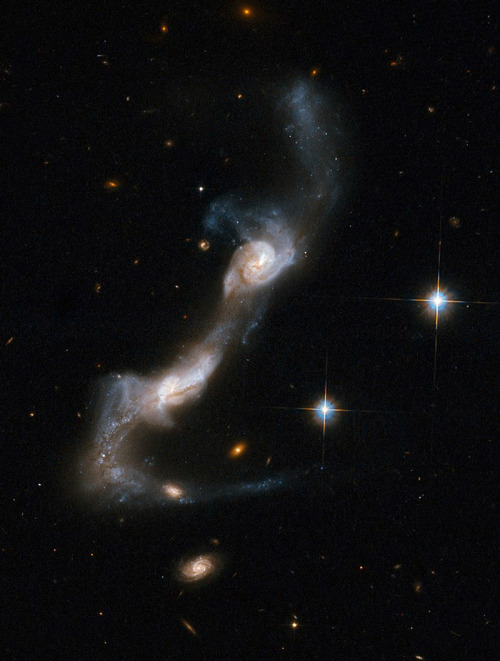NASA Hubble Space Telescope - The ‘Swan Nebula’

NASA Hubble Space Telescope - The ‘Swan Nebula’
More Posts from Ad-astra-affecte-spe and Others






The Moon
The most ridiculously detailed" image of Earth’s lunar neighbor was a two-year project captured by two astrophotographers.
The 174-megapixel image, which shows the moon’s colors, craters and glowing aura in stunning detail, was first revealed on Reddit on Saturday. Through Reddit and Instagram, Andrew McCarthy, known for his breathtaking astrophotography skills, teamed up with planetary scientist and fellow photographer Connor Matherne, who has been acclaimed for his striking and vibrant photos of galaxies and nebulae.
The two previously worked together to create an incredible glowing and detailed image of the moon.

The original Voyager 1 "Blue Movie" which records its approach during a period of over 60 Jupiter days (January 6 - February 3, 1979)


Galaxies can merge, collide, or brush past one another — each of which has a significant impact on their shapes and structures. As common as these interactions are thought to be in the Universe, it is rare to capture an image of two galaxies interacting in such a visibly dynamic way. This image, from the NASA/ESA Hubble Space Telescope, feels incredibly three-dimensional for a piece of deep-space imagery.
The subject of this image is named Arp 282, an interacting galaxy pair that is composed of the Seyfert galaxy NGC 169 (bottom) and the galaxy IC 1559 (top).
Credits: ESA/Hubble & NASA, J. Dalcanton, Dark Energy Survey, J. Schmidt

M100: A Grand Design Spiral Galaxy

Cosmic Dance of Spiral Galaxies: Arp 238
A universe in motion seen from the International Space Station during a night pass over Earth.
(@ wonderofscience on Twitter)
Timelapse created from images courtesy of the Earth Science and Remote Sensing Unit, NASA Johnson Space Center(ISS061-E-110520-111341 eol.jsc.nasa.gov).
-
 xploseof reblogged this · 10 months ago
xploseof reblogged this · 10 months ago -
 tierd-autistic-zorua liked this · 11 months ago
tierd-autistic-zorua liked this · 11 months ago -
 cute-alma123 liked this · 11 months ago
cute-alma123 liked this · 11 months ago -
 the-yearning-astronaut reblogged this · 11 months ago
the-yearning-astronaut reblogged this · 11 months ago -
 sensual-marriage-therapy liked this · 11 months ago
sensual-marriage-therapy liked this · 11 months ago -
 tbalsillie1973 liked this · 11 months ago
tbalsillie1973 liked this · 11 months ago -
 nib333 liked this · 11 months ago
nib333 liked this · 11 months ago -
 mstiemountainhop liked this · 11 months ago
mstiemountainhop liked this · 11 months ago -
 ssilentccry liked this · 11 months ago
ssilentccry liked this · 11 months ago -
 resting-distressed-face reblogged this · 11 months ago
resting-distressed-face reblogged this · 11 months ago -
 resting-distressed-face liked this · 11 months ago
resting-distressed-face liked this · 11 months ago -
 astra-deities reblogged this · 11 months ago
astra-deities reblogged this · 11 months ago -
 navegantecosmico liked this · 11 months ago
navegantecosmico liked this · 11 months ago -
 manessha545 liked this · 11 months ago
manessha545 liked this · 11 months ago -
 ad-astra-affecte-spe reblogged this · 11 months ago
ad-astra-affecte-spe reblogged this · 11 months ago -
 lizaislovely liked this · 11 months ago
lizaislovely liked this · 11 months ago -
 cat82 liked this · 11 months ago
cat82 liked this · 11 months ago -
 fapaul24 liked this · 11 months ago
fapaul24 liked this · 11 months ago -
 nostalgia-or-love reblogged this · 11 months ago
nostalgia-or-love reblogged this · 11 months ago -
 tthomusic liked this · 11 months ago
tthomusic liked this · 11 months ago -
 armameery reblogged this · 11 months ago
armameery reblogged this · 11 months ago -
 armameery liked this · 11 months ago
armameery liked this · 11 months ago -
 kng-fisher reblogged this · 11 months ago
kng-fisher reblogged this · 11 months ago -
 andromeda1023 reblogged this · 11 months ago
andromeda1023 reblogged this · 11 months ago -
 andromeda1023 liked this · 11 months ago
andromeda1023 liked this · 11 months ago -
 thecosmarnaut liked this · 11 months ago
thecosmarnaut liked this · 11 months ago -
 nameee3 liked this · 11 months ago
nameee3 liked this · 11 months ago -
 earthenhusk reblogged this · 11 months ago
earthenhusk reblogged this · 11 months ago -
 xploseof liked this · 11 months ago
xploseof liked this · 11 months ago -
 charleybee liked this · 1 year ago
charleybee liked this · 1 year ago -
 wakayume liked this · 1 year ago
wakayume liked this · 1 year ago -
 elenath9 liked this · 1 year ago
elenath9 liked this · 1 year ago -
 viridare reblogged this · 1 year ago
viridare reblogged this · 1 year ago

★•Astronomy, Physics, and Aerospace•★ Original and Reblogged Content curated by a NASA Solar System Ambassador
204 posts


